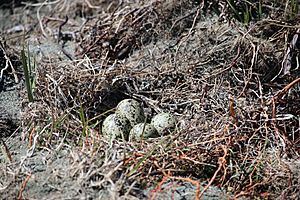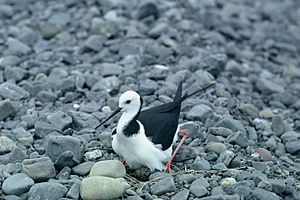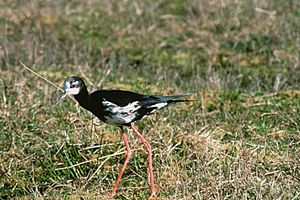Black stilt facts for kids
Quick facts for kids Black stilt |
|
|---|---|
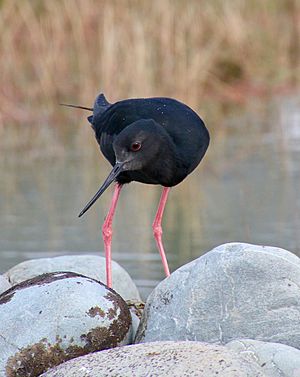 |
|
| Captive kakī in Department of Conservation Breeding Facility, Twizel, NZ | |
| Conservation status | |
| Scientific classification |
The black stilt (Himantopus novaezelandiae), also known as kakī in Māori, is a special type of wading bird that lives in New Zealand. It's one of the rarest birds in the world! In May 2020, there were only 169 adult kakī left in the wild.
Adult kakī are easy to spot because they are completely black. They also have long pink legs and a long, thin black beak. These birds mostly breed in the Mackenzie Basin on the South Island. Sadly, they are in danger because of introduced animals like feral cats, ferrets, and hedgehogs. Their homes are also being changed by hydroelectric dams, farming, and invasive weeds.
Contents
About the Black Stilt
What is a Black Stilt?
Black stilts belong to a group of birds called Himantopus, which also includes avocets. They are related to pied stilts (Himantopus himantopus), but they are different in their genes and how they act. Even though they are different, they can still have babies together. This mixing with pied stilts is one of the reasons black stilts are so endangered.
Long ago, the ancestors of black stilts came to New Zealand from Australia. Over time, they became completely black. Later, in the early 1800s, more pied stilts arrived from Australia.
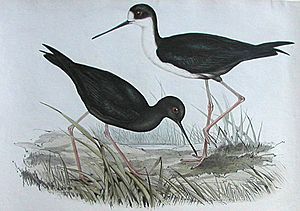
How to Spot a Black Stilt
Black stilts are medium-sized birds, weighing about 220 grams. They have very long pink legs, bright red eyes, and a long, thin black beak. Their feathers are a distinct shiny black.
Young black stilts look a bit different. They have a white chest, neck, and head, with a black patch around their eyes. Their belly feathers are black, which helps tell them apart from young pied stilts. Black feathers usually appear when they are one or two years old. Being black might help them stay warm in the cold, windy places where they live, like riverbeds and lake shores.
Birds that are a mix of black and pied stilts (called hybrids) can look very different. However, they usually have black chest feathers, which pure pied stilts never have.
Where Black Stilts Live
Past and Present Homes
Today, black stilts only breed in the braided river systems of the South Island. But in the past, before people arrived, their bones show they lived in many different places. They were found in narrow bush streams in Hawkes Bay and even in a wetland lake surrounded by forest in North Canterbury.
In the 1800s, they bred on riverbeds and in wetlands across the central and eastern North Island, and most of the South Island (except Fiordland). As late as the 1940s, they were still common in South Canterbury and Central Otago. They even nested in Central Otago until 1964.
Over time, pied stilts have largely replaced black stilts in many areas. Pied stilts arrived in New Zealand after humans settled there, and now there are about 30,000 of them.
Current Breeding Areas
Currently, black stilts only breed in the upper Waitaki River system in the Mackenzie Basin. Most black stilts stay in the Mackenzie Basin during winter. However, about 10% of them, especially hybrids or those paired with pied stilts, fly to North Island harbours like Kawhia and Kaipara in January for the colder months.
Black Stilt Life
Breeding Habits
Black stilts usually start breeding when they are 2 or 3 years old. Unlike pied stilts, which nest in groups, black stilts build their nests alone. Both parents work together to build a nest in July or August. They choose stable islands or banks in a shingle riverbed. Black stilt pairs often use the same nesting spot every year.
They lay three to five eggs between September and December, with most eggs laid in October. The eggs are kept warm for about 25 days until they hatch. The chicks take six to eight weeks to grow their feathers and learn to fly. After that, they stay with their parents for another six to eight months.
Protecting the Black Stilt
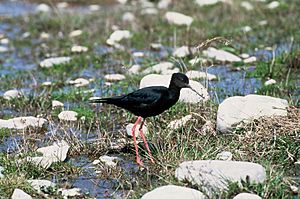
Even with 20 years of hard work to protect them, the black stilt is still one of the rarest wading birds and one of the most endangered birds in the world. In the 1940s, there might have been 500–1000 black stilts. But their numbers dropped quickly in the 1950s, and by 1962, only 68 adults were counted.
Intensive efforts to save them began in 1981, when there were only 23 adult birds left. By 1984, there were 32 adults in the wild, and by 1992, that number grew to 52 (with another 32 in captivity). As of May 2020, there are about 169 adult black stilts in the wild. There are also birds kept in captivity for breeding, and their chicks are released into the wild. Releasing these captive-bred birds and controlling predators have likely stopped the black stilt from disappearing completely. In August 2019, the Department of Conservation released 130 young birds onto the Godley, Cass, and Tasman rivers.
Main Threats
Predators
Animals that were brought to New Zealand, like mustelids (such as stoats, ferrets, and weasels) and cats, are the biggest danger to black stilts. These predators were released in the Mackenzie Country in the 1800s to control rabbits.
Black stilts are very vulnerable to these predators because:
- They nest on riverbanks, not on safer islands.
- Their nesting season starts in late winter when there are fewer rabbits for predators to eat.
- They currently nest alone, so they don't have the protection of a group (though they used to nest in colonies when there were more of them).
- They are more noticeable than pied stilts.
- They are less likely to pretend to be hurt to distract predators when they are on their nests.
- Their chicks take longer to learn to fly.
To help, people use traps and electric fences around black stilt nesting areas to control these predators.
Hybridisation
Mixing with the much more common pied stilt is also a big threat to the black stilt's unique genes. This mixing happens because there are so few black stilts left. Black stilts try to choose the darkest partner they can find, but sometimes they have to pair with a pied stilt because there are no other black stilts around. Black stilts mate for life, so if one pairs with a pied stilt, it's lost from the black stilt breeding group.
Habitat Loss
Black stilts need wetlands and braided riverbeds to find food. But many of these areas have been drained or changed for farming, irrigation, and flood control. Invasive weeds like Russell lupin and crack willow can grow in braided riverbeds. This reduces the places where black stilts can nest and gives predators places to hide.
Because black stilts nest on braided river beds, changes in river flows from hydroelectric dams also threaten them. For example, in the Upper Waitaki, some riverbeds were getting less water, which allowed weeds to grow into black stilt breeding areas. These weeds provided cover for predators. So, since 1991, a new water flow plan has been put in place to reduce the weeds. Also, lowering the water level of Lake Benmore sometimes creates temporary feeding areas for black stilts in the river deltas that flow into it.
Images for kids
See also
 In Spanish: Cigüeñuela negra para niños
In Spanish: Cigüeñuela negra para niños



